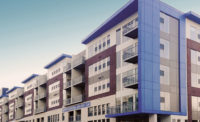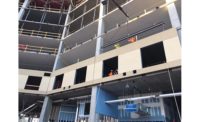Far away from the hustle and bustle of a big city, Silver Creek Resort in Snowshoe, W. Va., has gotten a new lease on life. The nine-story high rise building, with 239 condominiums, has recently undergone a complete renovation, and this time they are “doing it right,” according to Sam Collins, who is the general manager and acting project manager, as well as being a resident for six years at Silver Creek.
“Our original cladding was a panelized EIFS and we’ve had water leaks since the beginning in 1985 but that’s because it wasn’t installed or maintained correctly,” said Collins. “This time we worked with an architect and looked at metal panels, fiber cement and other claddings, and selected a 5-inch drainable StoTherm Lotusan NExT (EIFS) from Sto Corp. because it was the best fit for our needs and the best R-value.” A 5-inch drainable EIFS provides an approximate R-19 of continuous insulation, also referred to as “CI.”
The NExT system includes StoGuard, a fluid-applied waterproofing air barrier, and StoLit Lotusan, a finish with a pronounced self-cleaning effect, and five inches of continuous insulation. These three components create a high-performing, eye-catching wall cladding system that saves energy and stays attractive for years. This Sto reStore project consisted of 125,000 square feet of the company’s wall cladding.
Snowshoe’s weather and climate make for the best snow in the Southeast. It also results in some of the most extreme wind, snow and rain in the Southeast and prior to the renovation, every time a severe storm came through Silver Creek, management had to deal with damaged carpets, replace drywall, fix popcorn ceilings, and continue to “band aid” the problem.
“Each time we had a storm with any wind-driven rain, we had anywhere from moderate to severe damages that our maintenance department had to work numerous hours to repair, costing us anywhere from $5,000 to $20,000 in repairs each year,” says Collins.
According to Collins, at the time the original EIFS was installed there was no option for substrate protection, air barriers or drainable systems, but that has changed greatly over the years. Bill Perry, senior project manager of Pillar Construction, says the key to any cladding project is to know what you are doing. “The technology has vastly improved in 20 years, and with the latest and greatest in air barriers and finishes, this was the perfect solution for Silver Creek.”
Before starting the project, sections of the building had to be opened up to identify the existing condition behind the wall. All of the issues had to be identified—the way the EIFS panels were hung on the building, the window leakage issues, and the imperfect seals - so that they could create a solid, water-tight building in the new cladding.
The team, which included Pillar Construction Inc. as the general contractor, Keast and Hood Co. as prime consultant and structural engineer, Williamson & Associates as building envelope consultants, and Peter Fillat Architects, along with Sto, all worked together from the beginning to create a durable, watertight, and energy efficient building.
“We had to remove all of the original exterior skin including the EIFS, exterior sheathing and wet wall cavity insulation before we could begin,” says Perry. “The trend now is to insulate outbound of the exterior sheathing taking the insulation out of the cavity, and we did just that.”
| Pillar Construction |
|
Pillar Construction is a full service specialty contractor doing business for more than 15 years in various markets in the U.S. Established in the Washington D.C. area, the company currently serves the east coast and the southwest regions from its regional offices. The company’s architects, engineers, construction professionals and applicators combined experience qualify the contractor to deliver top-notch quality. In addition to ABAA, AWCI and other certifications, the experience in rainscreen façade systems, air and moisture barriers, insulation, exterior sheathing and framing, and sealants makes Pillar a seasoned building skin contractor. The company and its staff understands and manages all the components of the building envelope for a seamless application with a more controlled installation and better sequencing of all the pieces. After completing Silver Creek, Pillar Constructions’ restoration team that included Goran Kukic, Elmer Castro and Fredis Guerrero under the supervision of Bill Perry, have moved on to work on another building skin restoration project. |
THE BEGINNING
Sam Collins and members of the board of directors at Silver Creek Resort knew they had to do something. Their building was leaking, and had been for more than 25 years, and the damage to the building was just going to escalate. After looking at up to 10 different cladding options, they decided on using EIFS. They found two companies on the East Coast and invited them to meet with them.
“Pillar Construction was impressive and we liked the work they’ve done,” says Collins.
According to Perry, they showed them vivid illustrations of what the building would look like, and when chosen, they got involved with budgeting and selection of the system from the beginning. After the initial drawings, they worked with architect, Peter Fillat, who came up with the plans.
“We created drawings and worked closely with Williamson and Associates,” says Fillat. “It was a big job and a gigantic, interesting building. Nobody wanted to change the architectural façade—it’s strong—and they wanted to keep it simple.”
According to Perry, the options Pillar provided, and the solution that the entire team presented, gave the board clarity and a better understanding of what they had and how to solve the problems to create something very special. “One of the key selling points was the air and moisture barrier, which is now code in most states,” says Perry.
Adding a continuous air and moisture barrier was crucial, and gave the building a much truer R-value. The air barrier connected to the windows to give it a tight seal.
All 740 windows needed to be replaced. The new windows, which were Wojan M950 Series thermal break horizontal sliding and fixed window assemblies, were also a large factor in the energy savings.
“The previous installation was required to have expansion joints between each panel, but because we removed everything down to the studs we were able to eliminate the panel to panel joints in the substrate,” says Brock Osborn, Sto’s business development manager of restoration. “This allows the air barrier to run continuously between the panels and allows for less opportunity for water and moisture to get in.”
CHALLENGES
The project was done in two phases over more than two years. The building was occupied during the entire transition, with full-time residents and vacationers. This is a large property and getting all the ownership together to begin the renovation was the first challenge, according to Perry.
The next challenge was the climate. Silver Creek is located on the Ski Slopes and sits at 4,200 feet above sea level and the annual average snow fall is 180 inches. The decision to renovate was made in early 2011, however, because of the snowy winters, they needed to wait until summer to get started. The first snow falls in October and can stay as late as April. So to keep it dry, they first wrapped the building, and then sealed it to keep it enclosed for four to five months of hard weather. Through this time, the building stayed occupied.
The final challenge was the location. A beautiful and remote resort location, even the closest Home Depot, according to Perry, was three hours away. There is also limited use of cell phones, because of its proximity to the National Radio Astronomy located in nearby Greenbank, W. Va. The crew, which was up to 60 people at any one time, committed two to three months at a time, and stayed on the property.
“We made site visits to the remote building location on almost a weekly basis,” says Craig Swift of Keast and Hood, the structural engineering firm on the project whose main role was repairing the metal stud backing. Much of the metal stud cladding wall system had been significantly corroded and deteriorated, though the primary structural system was in fairly good shape. “The key structural challenge was to design repairs and replacement of the metal stud walls without requiring removal of interior finishes or access from the interior. Ultimately, a team effort from all parties overcame the challenges to get to a great end result.”
TESTING: ONE, TWO, THREE
According to Fillat, there were several water tests and inspections along the way, including after the windows were installed.
Scott Johnson, an inspector with Williamson & Associates, came out during phase one with window water testing and came back during phase two to test the windows and claddings related to the openings.
“The building tested out fine,” says Johnson. “There was a major storm during the final phase of construction, with 85 mph winds and hard rain, and there were no leaks. We attribute this to the EIFS and windows, and of course, the installation.”
Johnson and his team performed the ASTM E1105, a uniformed static pressure test to evaluate water infiltration performance, capabilities of windows and related construction on the building. Testing was performed at the most stringent requirements. They tested each assembly for 15 minutes.
The end result is a beautiful, dry building, changed from white to earth tones. The new main cream color, with a separate forest green color inset, gives the building a distinct profile and more depth, according to Fillat. This is the first time Fillat had ever worked with a drainable EIFS cladding and he feels it’s a great solution to a long-standing problem.
An interesting addition to the resort is that it now has the logo and signage built into the building, which they have never had before. On the end of one of the wings of the building are two foot high letters stating Silver Creek Lodge, and on the front of the building Silver Creek’s logo is added, which includes the name and a skier with swoops being cut into the building. The front logo letters are up to 8 feet tall.
“And not only does it look good, people are noticing drastic changes in their utility bills—with a savings now of 20 to 50 percent,” says Collins. “It’s quieter, too. Being a ski resort the noise reduction from the outside has been a big improvement since in the winter time you have ski guns and grooming machines running all of the time. And another benefit is that from inside my residence I can no longer hear the wind blowing or have snow in my living room each morning when I wake up.”










Report Abusive Comment